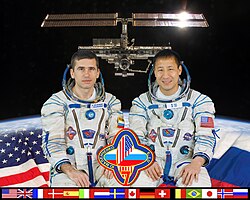Expedition 7
| Expedition 7 | |||
 | |||
| Uppdragsstatistik | |||
|---|---|---|---|
| Rymdstation: | ISS | ||
| Start: | 28 april 2003, 05:56:20 UTC[1] | ||
| Slut: | 27 oktober 2003, 22:17:09 UTC[1] | ||
| Antal besättningsmedlemmar: | 2 | ||
| Transport | |||
| Uppskjutning: | 26 april 2003, 03:53:52 UTC med Sojuz TMA-2 | ||
| Uppskjutningsplats: | Kosmodromen i Bajkonur | ||
| Landning: | 28 oktober 2003, 02:40:20 UTC med Sojuz TMA-2 | ||
| Landningsplats: | Kazakstan | ||
| Kronologi | |||
| |||

Expedition 7 var den 7:e expeditionen till Internationella rymdstationen (ISS). Expeditionen började den 28 april 2003 på Expedition 6:s besättning återvände till jorden. Expedition avslutades den 27 oktober 2003 då Sojuz TMA-2 återvände till jorden med Expedition 7:s besättning.
Besättning
| Position | (28 april - 27 oktober 2003) |
|---|---|
| Befälhavare | Hans tredje rymdfärd |
| Flygingenjör 1 | Hans tredje rymdfärd |
Redusering av besättningen
På grund av haveriet av rymdfärjan Columbia under återinträdet i jordens atmosfär under STS-107 flygningen den 16 januari 2003. Förlades NASA:s kvarvarande rymdfärjor med flygförbud. Detta ledde till att man inte kunde garantera flödet av förnödenheter till rymdstationen.
För att inte behöva lämna stationen obemannad valde man att reducera besättningen till två personer. På så vis klarade man försörja stationen med endast Sojuz och Progress farkoster.
Aleksandr Kaleri skulle varit den tredje medlemmen av Expedition 7. Han flög senare som medlem av Expedition 8.
Referenser
- ^ [a b] NASA's Space Station Expedition 7, läst 28 augusti 2016.
Externa länkar
| |||||||||||||||||||||
Media som används på denna webbplats
The International Space Station (ISS) Expedition Seven patch consists of two elliptical orbits which evoke the histories of the two space programs from which the crew is drawn. The Russian and American flags are intersecting, representing the peaceful cooperation of the many countries contributing to the ISS. Two stars indicate the Station's goals of contributing to life on Earth through science and commerce.
The International Space Station (ISS) Expedition 6 crew patch depicts the station orbiting the Earth on its mission of international cooperation and scientific research. The Earth is placed in the center of the patch to emphasize that work conducted aboard this orbiting laboratory is intended to improve life on our home planet. The shape of the Space Station’s orbit symbolizes the role that experience gained from ISS will have on future exploration of our solar system and beyond. The American and Russian flags encircling the Earth represent the native countries of the Expedition 6 crew members, which are just two of the many participant countries contributing to the ISS and committed to the peaceful exploration of space.
This emblem represents the eighth long-duration expedition to the International Space Station. The banner encircling the Earth, as a stylized figure 8, combines the flags of the partner nations represented by the crew. The International Space Station is portrayed above the Earth in its assembly complete configuration. The names of the two crewmembers, Michael Foale and Alexander Kaleri, are depicted in the border.
Expedition Seven Commander Yuri I. Malenchenko (left), and NASA ISS Science Officer and Flight Engineer Edward T. Lu pose for their crew portrait while in training at the Gagarin Cosmonaut Training Center in Star City, Russia for their scheduled launch in a Soyuz TMA-2 spacecraft later this year. Malenchenko represents Rosaviakosmos, the Russian Aviation and Space Agency.







